Writing good blog posts are more than just the words.
You might post great information but….
– if it doesn’t grab attention
– if it’s hard to read
….it might never be read!
So here’s 10 tips to help you write better blog posts.
1. Use attention grabbing titles
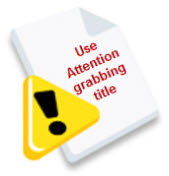 Titles on blog posts are like titles on books.
Titles on blog posts are like titles on books.
The better the title, the more it’ll grab the attention of readers and the greater the chance they’ll read what you’ve written.
Captivating and intriguing titles draw readers every time. Back that with a well written post and you won’t look back.
For further tips on writing post titles refer to 15 Ways to rework your next blog post title.
2. Use Short Paragraphs
Posts with really long paragraphs are really hard to read making it less likely for them to be read and more likely your readers will miss the point of your post.
It’s really simple:
- Break your posts up with paragraphs
- The more paragraphs the better
- Short paragraphs are better than long
- If you need to make some paragraphs one or two sentences long so they are visually easier to read online then do it!
- Make the first sentence of each paragraph make your readers want to read the rest of the paragraph
But avoid over use of bold, italics, colored font and so on — i.e. anything that makes it too hard to read the text or makes it visually uncomfortable to read.
3. Use Headings
Use headings, and where appropriate bullet points and number lists, to break up the post into manageable bit size chunks.
Creating a heading is as simple as:
- Highlighting the text you want to change into a heading
- Selecting the Heading Style you want to apply from the Advanced formatting toolbar (for most themes your best option is heading 3)
- Previewing your post to make sure that headings you’ve used has broken your post into manageable chunks
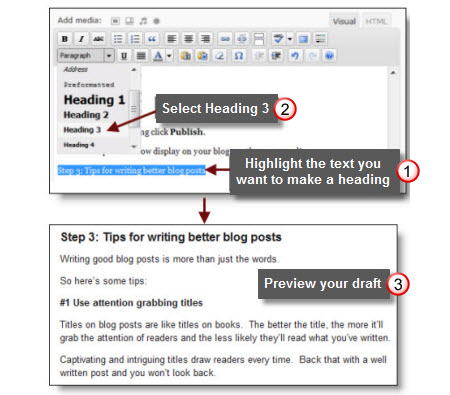
4. Remember to link
If you write about an article or another blogger’s post link to it!
Why? Because your readers often want to check it out in more details.
Linking is a really important part of being a blogger and linking isn’t hard but a common mistake of new bloggers is to forget to link!
It’s good blogging etiquette to link to:
- A person’s blog if you mention a blogger
- The post if you are talking about a particular post on a blog
- Articles and websites when you write about them
Here’s example of how you might link:
Sue Wyatt, one of the coordinators of the Teacher Challenge, has decided to lead by example and is participating in the Advanced series of 30 Days to Kick Start Your Blogging. Check out Sue’s Interviewing my blog!
Creating a hyperlink is as simple as:
- Highlighting the text you want to link to a website, blog or post
- Clicking on the Insert/Edit Link icon in the standard formatting toolbar
- Paste the link URL
- Then click Insert
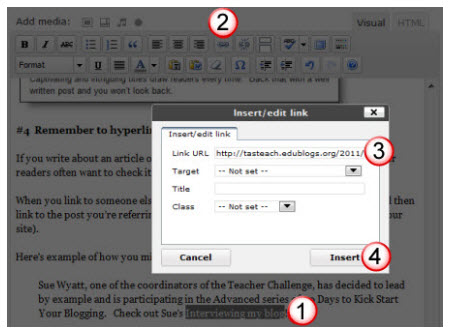
5. Use images effectively
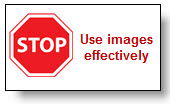 A picture tells a thousand words.
A picture tells a thousand words.
Effective use of images grab your readers attention and encourage them to read your posts.
Key aspects to consider include:
Resize images before using in posts
It’s really important to resize images before inserting into to your blog post as:
- You’ll find it easier to get the image to go where you want them to go; and to wrap text how you want it to wrap!
- Photos from digital cameras can be as large as 2.4 MB. They’ll unnecessarily use up blog storage space and the image will take longer to load in the post than the same image resized
Recommended sizes are:
- 450 pixels wide – if you want it to take up the full width of your post area (ideal for most themes)
- 150-200 pixels – to left or right align the image with wrapped text
Learn more about resizing photos here.
Don’t use copyrighted images
You can’t just use any image you like in a blog post.
Why? Because unless stated otherwise the law automatically grants full “copyright” over any creative work a person makes.
And if you’re thinking Fair Use Laws. Forget it!
It’s only really applicable in USA and won’t protect you from the rage that can be unleashed by someone whose copyright has been broken.
Learn to use Creative commons images or create your own images so you don’t get into trouble.
6. Enhance with embedded media
Embedding media like slides, videos, comic strips, quizzes, polls into your blog post take your posts to the next level.
It provides opportunities for readers’ engagement and interaction in ways not achievable using plain text and images.
So use them!
Here’s where you can learn more about enhancing posts using embedded media.
7. Subscribe to your posts
Blog readers are now reading your posts through a wider range of choices than ever before. From posts on your blog using a computer, to feed readers like Google Reader, or by email, via sites like Facebook to apps on mobile devices — they’re using it!
Your blog posts need to look good, visually, for all the different ways people are reading your posts.
And if you’ve only been focusing of your readers who visit your blog posts then you need to rethink! Visits to your blog is only make up a small proportion of your readers.
You need to:
- Take time to learn about RSS and email subscription.
- Subscribe to your own blog feed using your feed reader and your email subscription
- And basically check what your posts looks like when read the different ways.
This allows you to troubleshoot issues with font sizes, image size/alignment, removal of content like embeds and any feed issues.
Embeds like SlideShare, Voicethreads and videos can be removed in Feed readers and are removed in emails. Good practise is to embed the media and link to the location on the media.
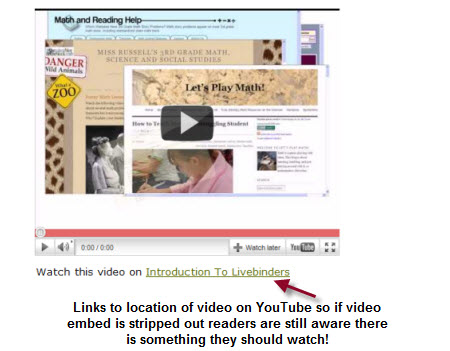
8. Don’t format like MS Word Document
Formatting posts using the Visual Editors works differently from how you can format documents using software like MS Word.
Accept that it works differently and you’ll make your life a lot easier.
For example, you can align separate images side by side in a Word Document but this often doesn’t work in posts.
The best option is to use a photo gallery or create one image from the images to make it look like separate images.
And you definitely DON”T write and format your post in MS Word and then paste it into your Visual Editor — won’t work!

9. Have a blogging routine
 Every blogger has periods where they struggle to write posts.
Every blogger has periods where they struggle to write posts.
Deciding on how many posts per week or month works best for you, and a routine to fit this means you’re less likely to suffer ‘blogger’s block’ and you’re more likely to consistently write better posts.
Here’s more information on post frequency and blogging routine.
10. And finally advice on what to blog about
 For many edubloggers blogging is a bit about their readers and a lot about their own personal needs to reflect on what they are learning or what they want to share.
For many edubloggers blogging is a bit about their readers and a lot about their own personal needs to reflect on what they are learning or what they want to share.
One of the commonest mistakes made by new bloggers is focusing on what they think their readers want to read.
Our advice is forget about your readers and focus on your own needs.
You’ll be more passionate and it’ll come through in your posts. And never assume that someone’s already written what you’re saying.
Final Thoughts
What have I missed?
- What are your 3 most important tips for writing better blog posts?
- What blog post recently has made you want to comment and what was it about this post that engaged you?
- Has a post recently inspired you to write your own post? What was it about the post that made you take action?
If you are enjoying reading this blog, please consider ![]() Subscribing For Free!
Subscribing For Free!
Sorry ! My previous comment was made at wrong post. Please delete this
>Option 2: Set-up a second account just for your students (and parents)
Is n’t against facebook’s terms and conditions to create a second account?
And you said that …just for an school/organization? How do you Create an account at FaceBook with a ‘non-person account ‘ ? FaceBook have strict policies and it allow only the legitimate ‘personal’ names . It strictly rejects the name if it seems as non-person 🙂
FaceBook allow us to create a fan page/group and a lot more for our organization and maintain it as you need. However you need to create the account with a standard name and not as an artificial person 🙂
@Tracy I’ve always felt the art of asking questions is probably one of the hardest things you can do as a blogger. Or in my case my hardest task is writing titles 🙁
And the principles are very similar to using Twitter. If you don’t follow that many people it is less likely you’ll get an answer. If you ask a question the wrong way, or haven’t built up relationships you’re less likely to get a response.
The simple rule is 90-9-1: 90% of users are lurkers (i.e., read or observe, but don’t contribute); 9% of users contribute from time to time, but other priorities dominate their time; 1% of users participate a lot and account for most contributions. Higher your readership the greater your chance that questions will be answered — if the topic interests the reader and is asked in the right way.
Thanks for the nice feedback about the Teachers Challenger. We’re really happy with how much it is helping others.
@Miss Room and Kathleen I think there is definitely a distinction between using colors on class / student blog. There are a lot of valid reasons why you would use colors with students.
@Debbie Glad the post has helped and do let us know how you go!
@Gail Great point about left justification and not centering it. I see lots of new bloggers tending to justify their posts and hadn’t considered that it makes them harder to read.
I never get hung up on spelling and editing errors. Why? Because for a person who has struggled with English and Language — I’ve come a long way.
@Kathleen regarding centring. I now need to do some good reading, especially in my feeds, to see how my eyes find it. But my approach is generally “What do the probloggers do?” rule. They spend considerable time working out what does/doesn’t work. If they don’t do it — there is normally a reason.
@Craig Welcome to blogging! I think the structure and content of your blog is coming along really well. The most important advice I would recommend is changing your font. Visually it looks nice but is making it harder to read your posts.
Thanks Sue!
PS I’ll try putting questions back in… and will remind myself of the 90-9-1.
Fantastic advice – thank you – just started up my own professional learning blog – check it out – would love your feedback.
http://mrkempreflects.blogspot.com/
Cheers
Craig
It’s always good news to find a Sue Waters Edublogger post in my Reader, yes Reader. I really depend on it to bring me the goods. I think a big part is the fact that I am not on Twitter or Facebook much during the day, so I would miss tweets about a good post somewhere in the blogging world.
Great points made by everyone above. I would add that folks should keep the reading simple by using left justification and not centering it. I too have tired eyes and find it taxing when searching for the start of each line.
I often struggle with finding a good question or two to end with but I can see how valuable it is in other people’s work. I will often leave a reply to a good question.
There are some captcha words that just kill me and if I haven’t copied my comment it is often lost so I don’t do a rewrite.
Lastly, I love the Scott’s comment on voice, as well as Kathleen’s on waiting to hit the “publish” button as we second guess ourselves.
Oh! and one other thing. I never get hung up on spelling or other editing errors. I find it refreshing to have folks send it along with a few typos. After all, we’re all friends here aren’t we?
@ Gail,
Great point about left justifying your text. I am guilty of using centring to make my work prettier 😳 I had never really thought about having to search for the start of the line but it definitely makes sense.
Sue, would you agree – left justifying is the way to go? I’m keen to make my work as easy to read as possible as I hate reading blogs that are difficult to read!
Kathleen
A great article that will help me update and improve my blogs…initial focus for me will be:
1. Use headings, bullet points and number lists. I haven’t used these and my text looks too traditional and weighty.
2. SHORTEN the paragraphs.
3. Write for me, focus on me, don’t worry about the reader.
4. Set a blogger schedule and follow it.
Tonight I change.
Great advice, several things I have to change ASAP or no one will read my blog…
a. Write for me, this is key. Focus on my message, not what I think the reader may want to read.
b. Use headings, bullet points and number lists…it is not a word document with paragraphs, IE not set in a traditional format.
c. SHORT paragraphs
d. Use topic sentences, still have to engage reader.
Starting next blog.
Great advice, including Scott’s about voice.
Following this advice, I will have solid blog posts.
What advice do you have about how to attract or drive people to your blog for them to read posts?
edtechzone.blogspot.com
Hi John,
1. Leave great comments. If people like your comments, they’ll often click through and read your blog to see what else you’re offering!
2. Hyperlink in your posts to other bloggers’ content. If you do, we’ll find it, guaranteed. As curious (and ego-driven!) humans, we’ll click through to see what you said about us. And then, again, if we like what we see, we’ll come back, start mentioning you in our posts, and so on.
3. MOST IMPORTANT: be interesting and helpful. Good content drives visitors and word of mouth.
4. Read this (if you’re brave):
http://bigthink.com/ideas/29975
Finally, be patient. Most bloggers give up too soon. Write regularly and frequently, give yourself six months, and if you’re still not sure you should keep blogging, drop me or Sue a note!
Thanks Scott. I was brave enough to read bigthink, and it really made sense. I started blogging in July 2010 and I am so happy with what I have accomplished. Do I have 2,000 subscribers a day? No, but I have been given the chance to share my knowledge with others.And that’s always a good thing!
Great Article! Thanks for laying it out so well. Of course, I had trouble with the “anti-spam word” but maybe I’m just going blind!!
Thanks again for putting together a well-written example of a good blog post.
This is great advice, including @Scott’s about Voice.
Following this advice, I will have a solid blog post.
Do you have any suggestions how to drive people to my blog and to read it?
edtechzone.blogspot.com
Hi Scott, can’t believe I left out the Voice (again!). Thanks for reminding me!
If I had to rate myself, besides C- for my constant struggle with writing attention grabbing headlines, I’d also mark myself down on voice — my personality doesn’t shine through as much nowadays as it once did. Need to ponder this for awhile.
Whereas your posts have a very definite and distinct voice as does Kathleen’s.
I would add ‘express your voice.’ In other words, don’t filter out YOU. No one wants to read dry, sterile, factual posts, even if they’re informational. Be conversational, let your personality shine through, take a stand on something (at least occasionally) and don’t worry about being controversial, etc. Add YOUR twist or lens or viewpoint to the topic. Otherwise you’re just one of hundreds writing about the same thing and we have other options as readers.
@ Scott,
That is very true. There have been a few times where I’ve written somewhat controversial posts and I’ve hesitated over hitting that publish button! It has always turned out really well though and generated a lot of insightful discussion. You have to be true to yourself!
Kathleen
Oh duh! Why am I pasting into Notepad rather than just pasting in HTML? You are always teaching me things, Sue!
Good point about asking questions. It would be disheartening to keep asking questions with no responses!
I have my grade twos finish their posts with questions from the start because they’re guaranteed to get some responses from their classmates, parents or even just me!
People who are not yet part of the blogging community probably do need to build up their readership and when they know people are reading, start asking the questions. Good point!
To increase readership I think you need to be an active part of the blogging community. That means reading and responding to a variety of blogs. I have seen many student bloggers lately visiting other blogs and writing a one line comment asking the blog owner to visit their blog. This isn’t the approach I encourage my students to take!
I also think if you follow the tips you mentioned you will build readership. You need to accept that you probably won’t have readers straight away. For my first few blog posts, I didn’t have any readers but you have to take a leap of faith and keep going.
If readers realise you offer interesting regular posts in an easy to read manner that come alive with good images/media they’ll subscribe and/or keep coming back.
Kathleen
HTML paste is a good option for the more experienced but not something I tell too much as I try to wean new bloggers off writing in Word. You have no idea of the number of blogs I have to fix a week due to the bad code 🙁
Very important to be an active member but as you Kathleen needs to be done in an appropriate manner.
@ Sue,
Excellent advice! I hope all bloggers read this one!
It is just so important to make your posts easy to read! If I see a big slab of writing with no paragraphs or headings, I just feel very reluctant to read it!
This is also something I teach my grade twos as I think even emergent writers need to realise the importance of producing easy to read text.
I am always telling people not to copy and paste from Word! I have learnt that the hard way. If I want to paste in text from another source (eg. Word) I paste it into Notepad and then copy/paste it in my post.
I have found that ending your post with a question often encourages comments and conversation.
One more tip would be to think about your font colour selection. I have seen new bloggers get excited by the range of font colours available and either make their post into a rainbow of colours or use a font colour that is very uneasy on the eye (eg. lime green). I like to use some colour (dark blue, purple, dark green, red) for headings etc and black for the main text.
Thanks for such clear and useful advice, Sue!
Kathleen
Hi Kathleen, thanks as always for nice words. It’s interesting that in a book you can get away with considerably longer paragraphs than you can online.
The other option is to click on your HTML tab, paste your text and then click on the Visual tab. The bad code is automatically removed this way.
Questions are always hard ones and I do encourage people use them. However for you and me — questions work well. But for a new blogger who is still building their readership it must feel disheartening if they don’t get responses. What would your advice to them be as they increase their readership and with using questions?
Colors is interesting. Edubloggers do like to use the color font. While I tend not to use it and prefer to follow the practised used by Probloggers. Probably the typical edublogger reader actually likes use of the color font.
Fabulous post and comments!
Sue, you hit this right on the money. Readership should be built before adding questions because it’s disappointing to not have responses, at least it was for me. (I think I even went back on a few posts and erased questions and added statements for a conclusions because it wasn’t working for me… hadn’t considered readership though.)
However, when I’m teaching kiddos to blog, having those questions make it easier for them to respond. Maybe they are used to answering questions. Maybe it helps them focus. Maybe their metacognition to know what they are actually thinking beside “That’s cool” isn’t mature enough to respond (at least when they too are newbies). I’m not sure.
But, it’s definitely a point to bring up to a newbie so they don’t give up or wonder what they are doing wrong.
On another note, I highly recommend the Edublog Challenges for Newbies to help them get started. It’s nice having a group going through the same learning curve at the same time.
Indebted,
Tracy Watanabe
Great advice on here thanks Sue! I have taken note of the html trick and I like the advice re Twitter (on a previous page of yours, sorry have been on a journey to this page) about thanking people for their follow. We need to remember to apply the courtesies we would use in daily life in our online world as well so I will do this from now on. After all is does give me a smile when someone follows me so I should ‘smile’ back.
To Kathleen, an interesting point re font colours. I have deliberately used this on my prep blog but only when recording the students thoughts. As they are beginning readers I want a way for them to easily identify their comment. So, when I’m typing it I read it aloud and then I ask the child what colour they would like and put their name at the end. Then I tell them that they can show their parents their comment at home, eg. Billy yours is the green one. It gives them a sense of ownership – knowing how to identify their comment (by colour and name) and teaches them that what they think, they can say, what they say can be written, and what is written can be read by others. There is a method to my madness!
@ Sue,
Great point about colours! This is a fantastic strategy for prep students and emergent readers.
I guess my angle was when I am teaching my grade twos to blog they immediately like to use a rainbow of colours which is okay but a lot of colours (lime green, yellow, aqua etc) aren’t very easy on the eye.
For your purpose, I’m sure you like to use as many colours as you can to distinguish students and that is a great idea.
Thanks for sharing,
Kathleen
hello mme.zundov im a star student sure